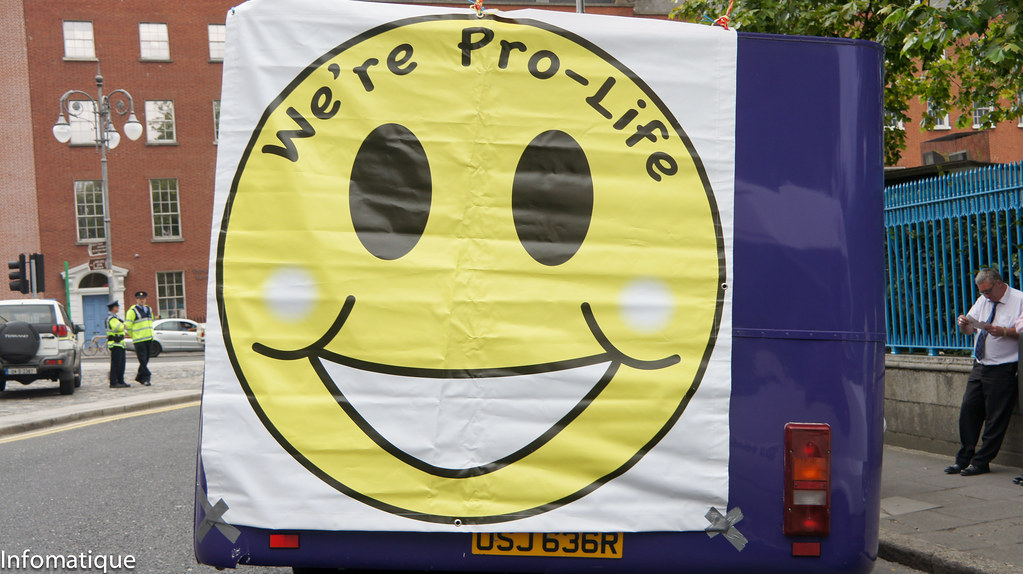Morality in the Womb: More than Meets the Mass’s Eye
by Max Kummerow
With the recent leaking of the draft decision by the U.S. Supreme Court to overturn Roe v. Wade, the heated controversy over a woman’s right to abort—or voluntarily terminate—a pregnancy is again at the forefront of democratic discourse. At the heart of this debate are issues of morality and theology. Self-identified Christians make up 63 percent of the U.S. population, with Evangelical Protestants and Catholics representing an overwhelming portion of the “pro-life” camp.
The question of when moral and legal obligations to protect a new life should begin has been pivotal to abortion politics and policy. Throughout history, four primary theories have been proposed to mark the commencement of a new human life:
- Moment of Conception
The moment of conception refers to when the egg and sperm unite to create a zygote with a unique genetic code. Those who hold that this is when life begins may argue for the prohibition of voluntary terminations or contraceptives used after conception, such as IUDs and hormonal methods that prevent pregnancy; that is, the implantation of a fertilized egg to the uterine wall.
- Quickening
The mother’s first sensation of the fetus moving—known as quickening—typically occurs between 16 and 20 weeks after the last menstrual period, or roughly the middle of the pregnancy. “Animus, soul, or life enters the body of the unborn infant when it first moves or stirs in the womb,” said the great 11th century theologian Thomas Aquinas. Aquinas and the Roman Catholic Church viewed the animation of the fetus in the womb as evidence of ensoulment, or the moment when a physical body has been joined with a human soul.
- Viability
The age of viability refers to the time during pregnancy when a fetus could be born with a reasonable chance of survival. The time at which a pregnancy becomes viable is typically around 24 weeks; however, babies born around this time have an increased risk of disability and other complications. Most delivered before the age of viability do not survive because the lungs and other vital organs aren’t sufficiently developed.
In Roe v. Wade, the Court divided pregnancies into trimesters. During the first trimester, the woman has sole discretion to terminate the pregnancy. During the second trimester, states can regulate—but not outlaw—voluntary terminations for the sake of the mother’s health. The fetus becomes viable at the start of the third trimester, at which time states can regulate or outlaw terminations in the interest of the potential life, except when termination is necessary to preserve the life of the mother.
- Breath of Life
The breath-of-life theory is that a new life begins at the baby’s first breath. This theory reflects the Christian creation story in Genesis 2:7, “And the LORD God formed man of the dust of the ground, and breathed into his nostrils the breath of life; and man became a living soul.” This theory makes the most sense to me. When, as a child, I helped my uncle pull calves, some died and some lived. To live, they had to breathe. My uncle himself died eventually, precisely when his breathing stopped.
Even birth and breathing haven’t always granted an individual protection under the law. Infanticide was common throughout the Roman Empire and many other parts of the ancient world, and has been documented in 27 countries. For instance, China’s one-child policy, implemented between 1980 and 2016, resulted in a wave of female infanticide. Scholars who have extensively studied infanticide have found a positive relationship between income inequality and female infanticide. These researchers concluded that societies with extreme poverty may use infanticide to conserve resources, reduce financial strain, or improve the family’s quality of life.

What does it really mean to be “pro-life?” (CC BY-SA 2.0, infomatique)
While there are some denominational differences amongst Christians regarding ensoulment and the beginning of life, we can safely assume that those against a woman’s right to choose believe this divine moment occurs sometime in the womb. Scripture, however, provides no guidance on voluntary terminations.
The closest The Bible comes to the topic is in Exodus 21:22-23, where Moses writes, “If two men are fighting, and in the process hurt a pregnant woman so that she has a miscarriage, but she lives, then the man who injured her shall be fined whatever amount the woman’s husband shall demand, and as the judges approve. But if any harm comes to the woman and she dies, he shall be executed.” If the embryo or fetus was ensouled, wouldn’t the men have received a more severe punishment according to the “eye for an eye” doctrine? Such is the case if the men kill the living, breathing woman. In other words, Scripture clearly implies that the fetus does not have a right to life equal to that of a breathing person.
The Science of Reproduction
Galileo begged the Inquisition to “look through the telescope” to see the truth about the solar system. Those against abortion services should look through a microscope to observe the lengthy, complex processes of conception and gestation. The authors of The Bible did not have the benefit of microscopy, and accordingly wrote nothing on the science of reproduction. To reconcile theology with science though, we must understand the biological facts of conception, fetal development, and birth.
First, the terms “moment of conception” and “beginning of life” are misleading, as these processes don’t occur in an instant. The actual beginning of life took place circa 4 billion years ago when DNA (or possibly even simple RNA, ribonucleic acid) first replicated. Some of the earliest “experiments” may have blinked out, but for several billion years—while innumerable organisms have died and species have gone extinct—life has continued with no interruption.
Nor is conception a “moment,” but rather a multi-step process—prefaced by episodes of meiosis and the production of male and female gametes—taking several hours for a sperm cell (male gamete) to penetrate an egg’s (female gamete) cell wall, stimulate the zona pellucida to deploy (preventing other sperm from entering), shed its axial filament (the “tail”), burrow into the egg, and redeploy genetic material until the collective 46 chromosomes have been linked into 23 pairs. By then, a fertilized egg (zygote) exists, ready for mitosis and another very gradual process of fetal development, but precisely when did the fertilization transpire? And is that unclear moment equivalent to “conception?” Or would conception be more appropriately consigned to the first mitotic division of the zygote?
One thing we do know is that only a relative handful of the quadrillions of potential combinations of DNA win the lottery, manifesting in zygotes and ultimately children. People across the political spectrum can agree that life is sacred, but even in the absence of abortion, most potential humans—even after conception—never experience the breath of life. While often tragic for aspiring mothers, stillbirths and infant mortality are nonetheless common features of human biology. In 2019, the U.S. infant mortality rate was 5.6 deaths per 1,000 live births. In poorer parts of the world, infant mortality is in the hundreds per 1,000 born.
Even with the advancements in medical technology, maternal mortality is still a risk everywhere. In the USA, the risk of death associated with childbirth is roughly fourteen times higher than that with legal abortion, making responsibly provided abortion significantly safer than childbirth. This is a point worth pondering for those who oppose abortion because they value human life, especially considering the Exodus distinction between the value of an adult woman relative to a fetus.
The Odds of Life
Charles Darwin discovered not only how species evolve via natural selection, but explained why organisms produce so many more than can survive. All species have an innate propensity to multiply. More specimens are born than can survive to adulthood; far more in the case of most species.
Meanwhile, the way organisms interact with and adapt to their environment determines their survival and reproduction. In this way, the most “fit” organisms (given the environmental conditions) begin to overtake less fit organisms, passing along more of their genetic code for traits ranging from eye color to blood type and even cognitive ability (which is influenced by genetic and non-genetic variables). The species evolves, in other words, and—assuming moderate rates of environmental change—becomes ever more fit or “successful.” One of the prerequisites of this progressive process is a surplus of specimens, from which the most fit are naturally selected.
Ensouled or otherwise, Homo sapiens is no exception. In the process of ovulation, an egg is released from the human’s ovary each month for roughly 30 to 35 years of fertility. This amounts to 350 to 400 chances of pregnancy. Of the roughly 300,000,000 sperm ejaculated during coitus, only around 200 reach the fertilization site in the oviduct. Even when one lucky sperm fertilizes an egg in the fallopian tube, half of fertilized eggs fail to implant in the uterus, becoming lost after conception and before pregnancy.
Table 1 reflects the reality of surplus reproduction from conception onward. Even given the substantial “drawdown” of zygotes and fetuses in 2020, there were 140 million births and only 59 million deaths, resulting in 81 million more people on Earth.
|
Table 1. Global Conception, Pregnancy, and Fetal Drawdown, 2020 |
||
| Total in Millions | % of Conceptions | |
| Conceptions | 475 | 100% |
| Pregnancies | 238 | 50% |
| (Unintended Pregnancies) | 107 | 45% |
| Involuntary Termination | 47 | 10% |
| Voluntary Termination | 50 | 10% |
| Births | 140 | 30% |
To the best of my knowledge, no woman has ever experienced 350 or 400 pregnancies. Cases such as the Octomom (fourteen children) and the Radford family (16 children) are famous because of how extreme they are (although a Russian woman supposedly produced 69 babies in the 18th century). What if all women could have fourteen to 16 pregnancies during their 30 to 35 years of fertility? Should that be the goal of a pro-life movement?
No society, even those with early marriages and lack of contraception, has averaged more than a dozen births per woman. Contraceptives and other family planning services have allowed most societies to reduce births per woman to more manageable levels. It would seem eminently logical that maximizing the number of human lives is neither desirable nor moral compared with moderating reproduction for purposes of healthy, happy, and sustainable lives.
Choosing Life
One of the cornerstones of steady-state economics is democratically stabilizing population; another is achieving fairness and quality of life. For these purposes, access to contraceptives, comprehensive sexual education, and family planning services are needed.

Considering the wellbeing of all life forms—or all God’s creatures—pro-choice is congruent with pro-life. (CC BY 2.0, Debra Sweet)
Better contraceptives and family planning services have already proven to reduce unintended pregnancies and abortions. In countries that restrict abortion, the percentage of unintended pregnancies ending in abortion has ironically increased from 36 percent to 50 percent over the past 30 years. In the end, if preventing the frequency of abortions is truly the goal, then widening access to sex education, contraceptives, and other forms of reproductive healthcare—even abortion itself—is the most effective course of action.
Ending abortions altogether, were it possible, would increase the number of children born each year by at least 50 million globally. These children would be born to families that, in many and probably the vast majority of cases, couldn’t afford them or are otherwise not prepared to assume the responsibilities of parenthood. Banning abortion would also increase maternal mortality and the presence of negative health effects in mothers and children.
In my opinion, an abortion should be considered a responsible parenting decision to the degree the pregnancy is unwanted. Unintended teen pregnancies are one of the leading circumstances for abortions in the USA. Among teens 15 to 19, 75 percent of pregnancies are unintended. Teenagers have many other chances (about 350 to 400) to be a mother when they are more prepared for the responsibility. An abortion allows the teenager to choose a better time to have a child who will grow up better cared for.
For a woman already with children, a decision to terminate an unwanted pregnancy lessens her family’s financial and psychological strain, and leaves more resources to be shared by her pre-existing children. In other words, terminating an unwanted pregnancy can reduce the burden on the mother, on society, and on the planet, or the fullness of God’s Creation for the faithful among us. In that sense, abortion too has a pro-life element.
 Max Kummerow is a population activist and researcher, and author of the forthcoming book, Too Many People.
Max Kummerow is a population activist and researcher, and author of the forthcoming book, Too Many People.







Thank you for this insightful article. It points out the folly of the so-called pro life (only until birth) argument. There are so many possibilities for reducing the number of abortions that can benefit women, families, and our earth.
Thank you for this informative and interesting article.
Brian, excellent article. It is unfortunate that more people are not members of CASSE. Keep up the excellent work.
While I agree wholeheartedly that there are too many people on this planet relative to its life support capacity and the needs of other non-human species, I disagree that murder can ever be condoned as a valid or ethical solution to this problem. To condone or celebrate abortion would imply that one is happy to read about killings of excess humans in other ways, be it euthanasia, suicide, crime, war, famine, or disease.
We do need to reduce human population, but we need to do it through moral means such as voluntary abstinence from sexual intercourse (which is already happening in our society as culture changes), not the snuffing out of life that already exists. Thus I disagree that abortion can ever, under any circumstances, be considered “pro-life”. For those of the opposite persuasion, consider that the argument made in the article above is exactly the same as Hardin’s controversial lifeboat ethics – that it is ethically justifiable to let certain less powerful people die if it serves supposedly greater goods like planetary sustainable and allowing the more powerful majority to survive. Lifeboat ethics is a slippery and dangerous slope toward moral relativism and ends justifying the means. Murder of our smallest and most defenceless members can never be justified if humanity wishes to stay on the moral high ground as a species.
These are my thoughts on this matter. Thank you for reading them.
Robert, It is revealing that you mention abstinence as a means to reduce population even though this method is very unpopular and guaranteed to not work (the side effects are awful!). There are other methods such as the IUD that are far better.
There is a fundamental difference between a fertilized egg and a born human. One can feel and think. The other cannot and never has. There is no practical difference between destroying the embryo just after conception or destroying the egg or the sperm just before conception. In either case, nobody has suffered and a child is not brought into existence.
Don’t worry about the “slippery slope”, since it is the countries that ban abortion that have the atrocious human rights records and the ones that permit abortion value all born lives.
Anti-abortion arguments using religion go against secularism. It’s unfair for non-Christians. Personally I believe there’re worse fates than death. A clip I saw recently of a journalist interviewing pro- life activists. The interviewer asked the pro-lifers what mothers should do with unwanted babies. The answer was ‘adoption’. He proceeded to ask them if they had kids. Answer was yes, they all had children. He asked ‘How many of them are adopted?’ None of the pro-lifers had any had any adopted children.